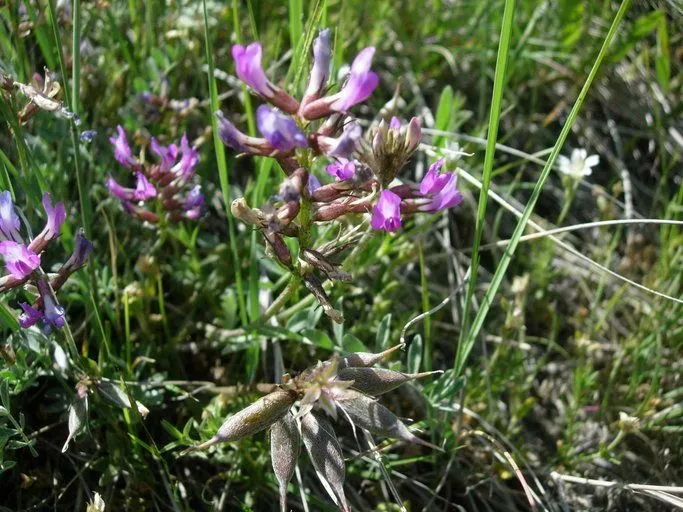
Author: Nutt.
Bibliography: Gen. N. Amer. Pl. 2: 99 (1818)
Year: 1818
Status: accepted
Rank: species
Genus: Astragalus
Vegetable: False
Observations: W. & C. Canada to WC. & C. U.S.A.
The Missouri milk-vetch, scientifically known as Astragalus missouriensis, is a captivating perennial herb belonging to the Fabaceae family. First described by the botanist Nuttall in 1818, this plant has intrigued scientists and nature enthusiasts alike with its unique characteristics and wide distribution.
Missouri milk-vetch appears to thrive in diverse environments, ranging from the western to central parts of Canada down through the western and central regions of the United States. This adaptability showcases the plant’s resilience and its ability to flourish in a variety of ecological niches.
The plant itself is notable for its erect, bushy growth, often reaching heights that allow it to stand out in the landscapes it inhabits. The leaves of Astragalus missouriensis are compound, featuring numerous small, oblong leaflets which give the foliage a finely-textured appearance. This characteristic leaf structure is typical of many plants within the Fabaceae family.
Perhaps most striking are the flowers of the Missouri milk-vetch, which typically bloom in vibrant shades of purple and violet. These blossoms not only add a splash of color to the plant’s green foliage but also attract a range of pollinators, contributing to the biodiversity of its native regions. The flowering period often draws the attention of botanists and gardeners who appreciate the visual appeal and ecological importance of this species.
As a member of the Fabaceae family, Missouri milk-vetch is part of a group of plants commonly known as legumes, which are renowned for their ability to fix nitrogen in the soil. This valuable trait helps in improving soil fertility and supports the growth of other plants in its vicinity, thereby playing a crucial role in its ecosystem.
Missouri milk-vetch has also been a subject of various botanical studies, providing insights into plant adaptation, symbiotic relationships with soil bacteria, and the processes underpinning nitrogen fixation. Its presence across a substantial geographical range further underscores its importance in ecological research and conservation efforts.
In summary, Astragalus missouriensis, or Missouri milk-vetch, is not just a striking plant with an enviable aesthetic but also a key player in maintaining the health and dynamics of its native habitats. Through its contributions to soil health and support of a vibrant pollinator community, it underscores the essential roles that native plant species play in broader ecological contexts.
Eng: missouri milk-vetch, missouri milkvetch
Fra: astragale du missouri
En: Missouri milk-vetch, Missouri milkvetch
Fr: Astragale du Missouri
Taken Oct 11, 2022 by Becher J (cc-by-sa)
Taken May 26, 2021 by Poulson lina (cc-by-sa)
Taken Oct 11, 2022 by Becher J (cc-by-sa)
Taken Apr 16, 2019 by Linda Lawliss (cc-by-sa)
Taken Sep 25, 2022 by Natalie Clement (cc-by-sa)
Taken Sep 25, 2022 by Natalie Clement (cc-by-sa)
Taken Aug 15, 2011 by EOL − RT Hawke (cc-by-nc)
Growth habit>: Subshrub, Forb/herb
Family: Myrtaceae Author: (F.Muell.) K.D.Hill & L.A.S.Johnson Bibliography: Telopea 6: 402 (1995) Year: 1995 Status:…
Family: Rubiaceae Author: Pierre ex A.Froehner Bibliography: Notizbl. Bot. Gart. Berlin-Dahlem 1: 237 (1897) Year:…
Family: Sapindaceae Author: Koidz. Bibliography: J. Coll. Sci. Imp. Univ. Tokyo 32(1): 38 (1911) Year:…
Family: Asteraceae Author: A.Gray Bibliography: Pacif. Railr. Rep.: 107 (1857) Year: 1857 Status: accepted Rank:…
Family: Fabaceae Author: Medik. Bibliography: Vorles. Churpfälz. Phys.-Ökon. Ges. 2: 398 (1787) Year: 1787 Status:…
Family: Aspleniaceae Author: (Cav.) Alston Bibliography: Bull. Misc. Inform. Kew 1932: 309 (1932) Year: 1932…